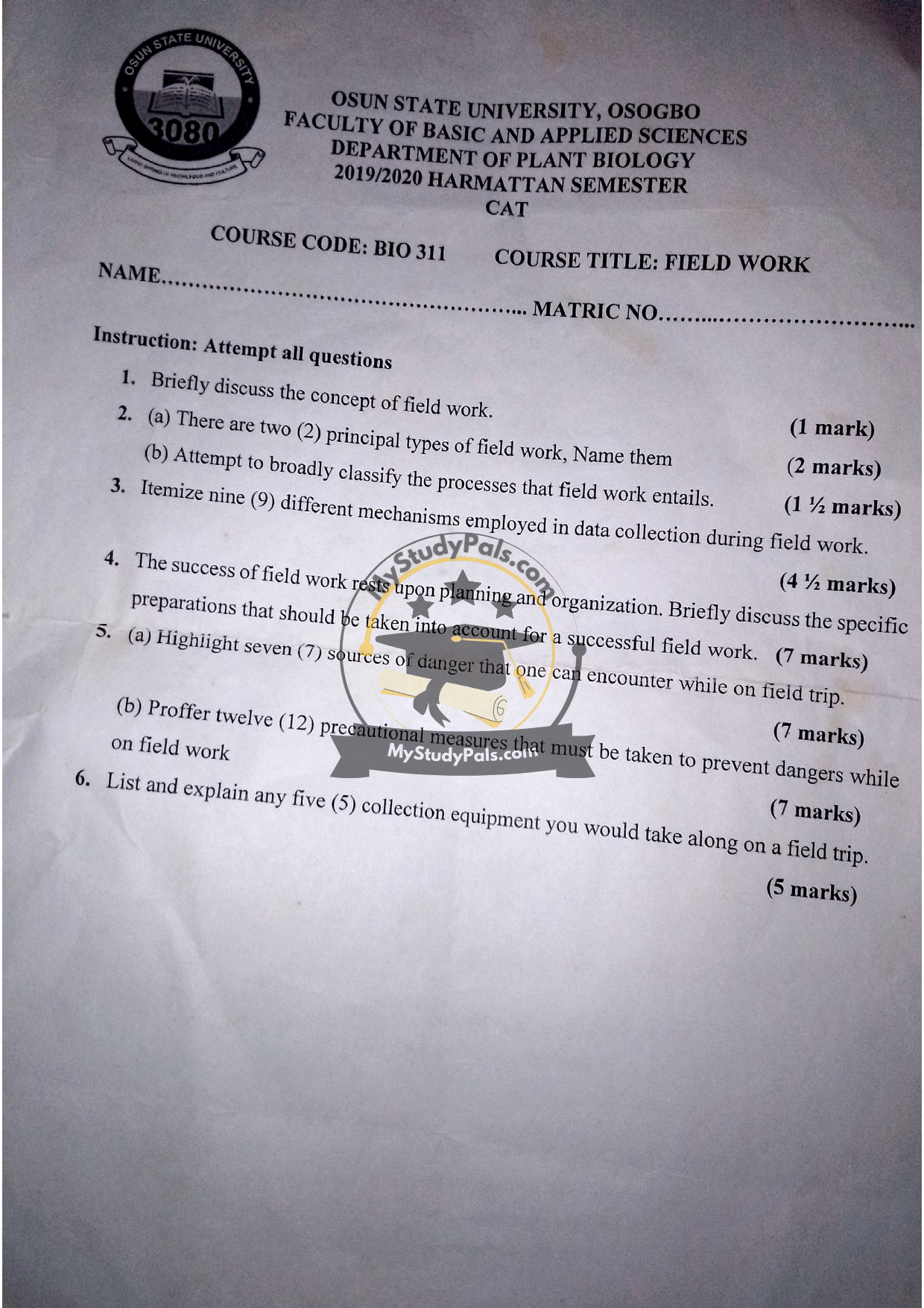ANWSER
### BIO 311 – FIELD WORK
Question 1:
Answer: Field work is a practical research activity conducted outside the laboratory or classroom, involving direct observation, data collection, and analysis in natural environments to study biological, ecological, or geographical phenomena.
Question 2 (a):
Answer: The two principal types of field work are:
1. Descriptive field work (qualitative observations).
2. Experimental field work (quantitative data collection and hypothesis testing).
Question 2 (b):
Answer: Field work processes can be broadly classified into:
1. Pre-fieldwork: Planning, logistics, and preparation.
2. Active fieldwork: Data collection, sampling, and documentation.
3. Post-fieldwork: Data analysis, reporting, and evaluation.
Question 3:
Answer: Nine mechanisms for data collection during field work:
1. Direct observation.
2. Sampling (random/systematic).
3. Interviews/questionnaires.
4. Photography/videography.
5. Specimen collection (plants, soil, etc.).
6. GPS mapping/GIS tools.
7. Measurement tools (e.g., quadrats, thermometers).
8. Field journals/note-taking.
9. Remote sensing/drones.
Question 4:
Answer: Preparations for successful field work include:
1. Objective clarity: Define research goals.
2. Site selection: Scout locations and obtain permits.
3. Equipment checklist: Ensure all tools are functional.
4. Safety protocols: First aid kits, emergency contacts.
5. Team training: Assign roles and review methods.
6. Weather/logistics: Transport, accommodation, backups.
7. Ethical considerations: Permissions and environmental impact.
Question 5 (a):
Answer: Seven sources of danger during field trips:
1. Wildlife encounters (snakes, insects).
2. Harsh weather (heat, rain, storms).
3. Terrain hazards (cliffs, slippery surfaces).
4. Equipment failure (e.g., GPS, vehicles).
5. Health issues (dehydration, allergies).
6. Human threats (theft, unsafe areas).
7. Plant-related risks (toxic species, thorns).
Question 5 (b):
Answer: Twelve precautionary measures:
1. Carry first aid kits.
2. Wear protective gear (boots, hats).
3. Stay hydrated and pack snacks.
4. Inform others of your itinerary.
5. Avoid solo trips; use the buddy system.
6. Check weather forecasts.
7. Learn basic survival skills.
8. Use insect repellent/sunscreen.
9. Secure equipment properly.
10. Follow ethical guidelines.
11. Be aware of local wildlife.
12. Emergency communication devices (whistle, phone).
Question 6:
Answer: Five collection equipment and their uses:
1. Plant press: Preserves plant specimens for herbarium.
2. Trowel: Digs soil/root samples.
3. Pooters: Captures small insects safely.
4. Magnifying lens: Examines fine details of specimens.
5. GPS device: Records precise location data.
—
### PRO 303 – COMPARATIVE PLANT ANATOMY
Question 1:
Answer: A. apical meristem
Question 2:
Answer: D. procambium
Question 3:
Answer: D. In the tips of stems and roots
Question 4:
Answer: C. apical meristem
Question 5:
Answer: C. meristematic tissues
Question 6:
Answer: A. pericycle
Question 7:
Answer: A. lateral meristem
Question 8:
Answer: D. xylem vessel elements
Question 9:
Answer: A. Sieve tube
Question 10:
Answer: C. sieve tubes
Question 11:
Answer: A. Plasma membrane
Question 12:
Answer: A. manufactured food
Question 13:
Answer: D. Phellogen
Question 14:
Answer: D. immature and living
Question 15:
Answer: A. Vascular bundles are 5-20 in number
Question 16:
Answer: C. thin-walled, densely protoplasmic, no intercellular spaces, isodiametric and nucleate



